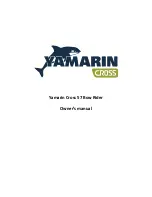
- 4 -
7
ELECTRICAL SYSTEM ................................................................................................. 41
7.1 GENERAL INFORMATION ABOUT THE ELECTRICAL SYSTEM .............................. 41
7.2 DC INSTALLATION (12 V) ............................................................................................ 42
7.2.1 Battery use and distribution............................................................................... 42
7.2.2 Battery switch ...................................................................................................... 44
7.2.3 Electrical layout - 12 V ........................................................................................ 45
7.2.4 *1 DC electrical schematic diagram - 12 V ........................................................ 46
7.2.5 Steering station ................................................................................................... 48
7.2.6 Fuses .................................................................................................................... 49
7.2.7 Anodes ................................................................................................................. 50
8
ONBOARD COMFORT.................................................................................................. 51
8.1 ELECTRONIC EQUIPMENT.......................................................................................... 51
8.2 EQUIPMENT OTHER THAN FOR PROPULSION, WHICH BURNS FUEL
(GENERATOR, HEATING) ............................................................................................ 52
8.2.1 General points ..................................................................................................... 52
9
WATER SYSTEMS ........................................................................................................ 53
9.1 GENERAL POINTS........................................................................................................ 53
9.2 USING A VALVE............................................................................................................ 54
9.3 FRESH WATER SYSTEM ............................................................................................. 55
9.4 MAIN PLUMBING EQUIPMENT.................................................................................... 57
9.4.1 Water unit ............................................................................................................. 57
9.4.2 Deck wash pump (Sea water) ............................................................................. 58
9.4.3 Cockpit shower.................................................................................................... 59
9.5 BLACK WATER SYSTEM (WC).................................................................................... 59
9.5.1 Location diagram of black water system (Specificity "US" only) ................... 60
9.6 WASTE WATER SYSTEM............................................................................................. 67
10 ENGINE.......................................................................................................................... 69
10.1 INFORMATION ABOUT THE RISKS OF FIRE AND OF EXPLOSION OF ENGINES..... 69
10.2 DANGER FROM MOVING MECHANICAL PARTS ....................................................... 71
10.3 GENERAL POINTS ....................................................................................................... 71
10.4 STARTING THE ENGINE.............................................................................................. 74
10.5 FUEL CIRCUIT .............................................................................................................. 75
10.6 ENGINE WATER INTAKE VALVE................................................................................ 76
10.7 FUEL FILTER ................................................................................................................ 77
10.8 ENGINE INSTALLATION.............................................................................................. 78
10.9 ENGINE CONTROL ...................................................................................................... 78
10.10 FLAPS ......................................................................................................................... 79
10.11 ACCESS TO THE ENGINE ......................................................................................... 82
10.12 PROPELLER ............................................................................................................... 82
Summary of Contents for CAP CAMARAT 7.5 CC serie 2
Page 1: ...992092 Index B CAP CAMARAT 7 5 CC OWNER S MANUAL ...
Page 2: ......
Page 6: ......
Page 10: ......
Page 12: ......
Page 16: ......
Page 20: ......
Page 24: ......
Page 34: ......
Page 46: ... 46 992092 Index B 7 2 4 1 DC electrical schematic diagram 12 V ...
Page 56: ... 56 992092 Index B Water tank Location Cockpit locker Capacity 80 litre WATER filler ...
Page 68: ......
Page 90: ... 90 992092 Index B 12 2 2 Rod holder 12 2 3 Seat cockpit 12 2 4 Pilot seat ...
Page 96: ......
Page 100: ......
Page 108: ......
Page 112: ... 112 992092 Index B ...





































